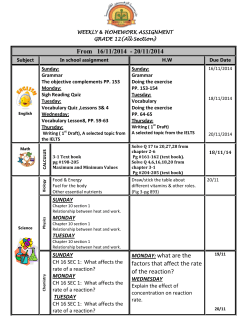
Everything you need to know to feel prepared for your walk
Everything you need to know to feel prepared for your walk Thank you for joining Team Macmillan. We think you’re amazing for having the dedication and commitment to organise your walk in aid of Macmillan. At the finish, the sense of achievement will be huge, knowing that you’ve not only completed your walk but you’ve helped people affected by cancer too. We’ve put together this handy little training guide to help you prepare if you’ve decided to take on a more difficult challenge. Getting started Although walking is something most people do every day, if you’re taking on something a little more challenging, the more prepared you are the more you’ll enjoy the experience. Look after your feet We’d strongly recommend buying a pair of good quality, fully waterproof leather or fabric walking boots. These should have a reasonably high ankle support and a stiff heel counter to give lateral support. There are lots of specialist stores out there where the staff will measure your feet correctly and recommend the right socks for you. Slow and steady wins the training race The length and duration of your first training walk depends on how fit you are. The best approach is to start slowly and build up over time. Your muscles and joints will take a while to adjust to being on your feet for many hours. So, avoid overdoing it on your first few training walks to reduce the risk of injury. Whatever your reason for taking part in your walk, it’s important to set yourself goals. This will give you something to aim for, which will keep you motivated. And don’t forget that every step you take will help us help someone affected by cancer. Eat well Diet will be important during training, so it’s worth identifying your nutritional goals and coming up with a healthy eating plan. This will improve your general health and ensure your body has enough energy to keep up the extra exercise. Make sure you’re eating a good mix of carbohydrates and stay well hydrated. You may also find eating a carbohydrate snack two to three hours before you train will help keep your energy levels topped up. Team Macmillan training schedules When training, getting used to being on your feet for several hours at a time is key. We’d also advise getting into some hilly countryside at the weekends to get yourself used to walking on a variety of terrain. We’ve designed the following 10 week training programme for those taking part in a more challenging walk. Although this programme focuses on spending time walking in the outdoors, you can also build up stamina by going to the gym, swimming or playing sports. But these are no replacements for the real thing, which is hiking in the hills with your rucksack and boots on. 10 week training schedule Week 1 Week 3 Week 5 Monday Rest Monday Rest Monday Rest Tuesday 30 minute walk, exercise circuit x 1 Tuesday 30 minute walk, exercise circuit x 1 Tuesday 30 minute walk, exercise circuit x 2 Wednesday Rest Wednesday Rest Wednesday Rest Thursday 30 minute walk, exercise circuit x 1 Thursday 30 minute walk, exercise circuit x 1 Thursday 30 minute walk, exercise circuit x 2 Friday Rest Friday Rest Friday Rest Saturday or Sunday 2 hour walk Saturday 3 hour walk Saturday or Sunday 5 hour walk Sunday 2 hour walk Week 2 Week 4 Week 6 Monday Rest Monday Rest Monday Rest Tuesday 30 minute walk, exercise circuit x 1 Tuesday 30 minute walk, exercise circuit x 2 Tuesday 30 minute walk, exercise circuit x 2 Wednesday Rest Wednesday Rest Wednesday Rest Thursday 30 minute walk, exercise circuit x 1 Thursday 30 minute walk, exercise circuit x 2 Thursday 30 minute walk, exercise circuit x 2 Friday Rest Friday Rest Friday Rest Saturday or Sunday 3 hour walk Saturday or Sunday 4 hour walk Saturday 6 hour walk Sunday 3 hour walk Week 7 Week 9 Monday Rest Monday Rest Tuesday 1 hour walk, exercise circuit x 3 Tuesday 1 hour walk, exercise circuit x 3 Wednesday Rest Wednesday Rest Thursday 1 hour walk, exercise circuit x 3 Thursday 1 hour walk, exercise circuit x 3 Friday Rest Friday Rest Saturday 7 hour walk Saturday 8 hour walk Sunday 4 hour walk Sunday 2 hour walk Week 8 Week 10 Monday Rest Monday Rest Tuesday 1 hour walk, exercise circuit x 3 Tuesday 1 hour walk, exercise circuit x 3 Wednesday Rest Wednesday Rest Thursday 1 hour walk, exercise circuit x 3 Thursday 1 hour walk, exercise circuit x 3 Friday Rest Friday Rest Saturday 8 hour walk Saturday 3 hour walk Sunday Rest Sunday 2 hour walk You may not always be able to fit in everything we’ve suggested in the training schedule. But if you make a few changes to your lifestyle, you may well find some extra training time. For example, you could: • g et up an hour earlier and go out for a quick walk before work • walk to or from work – even if it’s only once or twice a week • get off a stop or two earlier on the bus, underground, tram or train • park further away than usual and walk part of the route to work • take the stairs rather than the lift Training tips We’ve also put together some handy training tips which will hold you in good stead for the work ahead. The long and short of it After the first few weeks, build up your endurance by walking long, slow distances. Pick one day a week for your long walk, two evenings or mornings for your shorter ones and do circuit exercises to help build specific muscle groups. Wear your rucksack on the long walk so you get used to it. Mix it up To keep training interesting, vary the walks you do and invite friends to join you. Vary the types of surfaces and terrain you walk on too. The terrain can often vary on routes, with rocky bits, stones, tree roots, sandy bits, and steep ascents and descents. Stretch yourself Remember to stretch after every walk. You should also stretch once you’ve warmed up a bit (after about 10 minutes walking). Have a good rest Rest is as important as training. It’s vital that you allow your body adequate time to recover, so make sure you have enough recovery days. Keep fit and strong There’s no substitute for walking. However, cycling, swimming, playing squash, tennis or badminton, or working out at the gym for an hour or two will help with your general fitness. It’s fine to add this to your programme instead of one of the short walks. Make sure you stretch properly after each session. Blitz blisters Blisters happen when something rubs against the skin and causes fluid to form beneath it. The longer the friction goes on the more fluid forms, creating pressure and pain. Eventually the blister may burst, exposing raw skin which is more painful. New walkers usually get blisters because their feet are not toughened or they haven’t broken in new boots. Avoid them by: • b uying boots early and wearing them in – the more you wear them the more comfortable they will become • making sure your feet are dry so they don’t move around in your boots • wearing socks with fibres which draw moisture away from the skin – acrylic or polyester rather than pure cotton • lacing your boots correctly rather than too tightly or loosely – the irritation from pinching and rubbing will cause blisters Handy tip Did you know that if you’re taking on a walk in aid of Macmillan, Cotswold Outdoor will give you 15% off their products! Just email walks@macmillan.org.uk and ask for our discount code. Useful exercises These exercises are designed to strengthen specific muscle groups. It’s important to use just your own body weight in the early weeks. But in the latter weeks, you can add small weights to your ankles or put on your rucksack to help build strength. Calf raises Stand with your feet together, at arm’s length away from the wall. Have your fingers just touching the wall for balance. Raise yourself slowly on to the tips of your toes and slowly lower. Repeat 20 times. The idea of the circuit is to complete each exercise then move on to the next. Once you’ve finished all the exercises (ie one circuit), repeat the circuit as shown in the training programme. You can also increase the number of repetitions for each exercise from 20, 30, 40 or 50, depending on how strong you’re feeling. Don’t forget to stretch before and after the session to keep the muscles loose and long, rather than tight and short. Squats Stand with your feet shoulder width apart, hands on hips. Keep your back straight and head up while you slowly lower yourself so that your knees are bent 90 degrees. Then stand up so that your knees are locked straight. Repeat 20 times. Step ups Using the bottom step of a staircase or a low bench, start with your left foot on the step and your right foot on the floor. Stand up straight on your left leg, bringing your right foot up to the step and then lower back down to the floor. Repeat 20 times. Change leg and repeat. Leg extensions Sit on a high sofa, bed or bench with the backs of your knees just on the edge and your feet hanging down. Lean back, with your hands behind you for support. Keeping the back of your knee on the seat, slowly lift your left foot up so that your leg becomes straight, and lower again. Repeat 20 times. Change leg and repeat. Leg raises Lie on your stomach on a mat or soft floor with your hands under your chin. Keeping your left leg straight, slowly raise it six inches off the floor and then slowly lower. Repeat 20 times. Change leg and repeat. Enjoy yourself Now you’ve signed up to Your Walk, enjoy getting out in the great outdoors, and know that you’re helping to change lives as you do it. And, if you start losing motivation or finding training tough, just take a deep breath and remember this: we couldn’t do what we do without you. More support? If you have any more questions about training for your walk, stroll over to macmillan.org.uk/yourwalk or email us at walks@macmillan.org.uk If you’d like to know more about cancer or you’d like to speak to someone about your own experience, get in touch. We’re here for you every step of the way. Just call the Macmillan Support Line free on 0808 808 00 00 (Monday – Friday, 9am – 5pm). Or visit us at macmillan.org.uk Macmillan Cancer Support, registered charity in England and Wales (261017), Scotland (SC039907) and the Isle of Man (604).
© Copyright 2025









